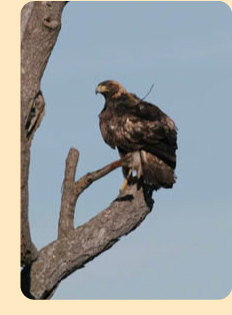 |
|||
|
|
|||
|
 The first two golden eagles were caught and tagged near Central City, PA. The first, a 3420 g (7 lb, 8.6 oz) male, was captured at 13:00 local time on 23 November 2006 (Thanksgiving Day!). This bird was at least four years old, but not quite a full adult. He was released at the Allegheny Front Hawkwatch and quickly moved south. The first two golden eagles were caught and tagged near Central City, PA. The first, a 3420 g (7 lb, 8.6 oz) male, was captured at 13:00 local time on 23 November 2006 (Thanksgiving Day!). This bird was at least four years old, but not quite a full adult. He was released at the Allegheny Front Hawkwatch and quickly moved south.
The second bird, a 3530 g (7 lb, 12.5 oz) male, was caught at 10:20 two days later, on 25 November 2006. This bird was younger - at least two years old. He was also released at the hawkwatch. This bird flew to a nearby tree and sat for a moment, watching us and getting his bearings, before heading north for a few minutes. Fifteen minutes later we watched him fly back by the hawkwatch, the telemetry unit on his back just as planned. On March 23, 2007, the third golden eagle in the program was released near Scherr, West Virginia. This male, approximately three years old, was accidentally trapped in West Virginia and rehabilitated at the National Aviary. When released he weighed 4000 g (8.8 lbs). You can read his remarkable story and follow his migration progress. To track these and the many other eagles we have transmittered since 2007, and to find out where they are on a regular basis, click below. We will update these files weekly or bi-monthly so that they contain the most recent information on the status of our golden eagle colleagues. We are now also collaborating with the Ministère des Ressources naturelles et de la Faune of the government of Quebec. Together with them we are tracking a number of golden and bald eagles and information on these eagles is provided in English and in French. The issue of development of wind power capacity and its influence on wildlife is highly complex. In this web page we only focus on the research side of the problem. For a brief summary of our position on some of the many other issues surrounding the development of wind power capacity in the central Appalachian region, please read our white paper. This document summarizes our project, provides our professional opinion on how we believe wind power should be developed, and gives information on our funding and on our data and publication policies. For questions, contact Dr. Steven Latta, Director of Conservation and Field Research. This research project is in collaboration with the following organizations: 


|



